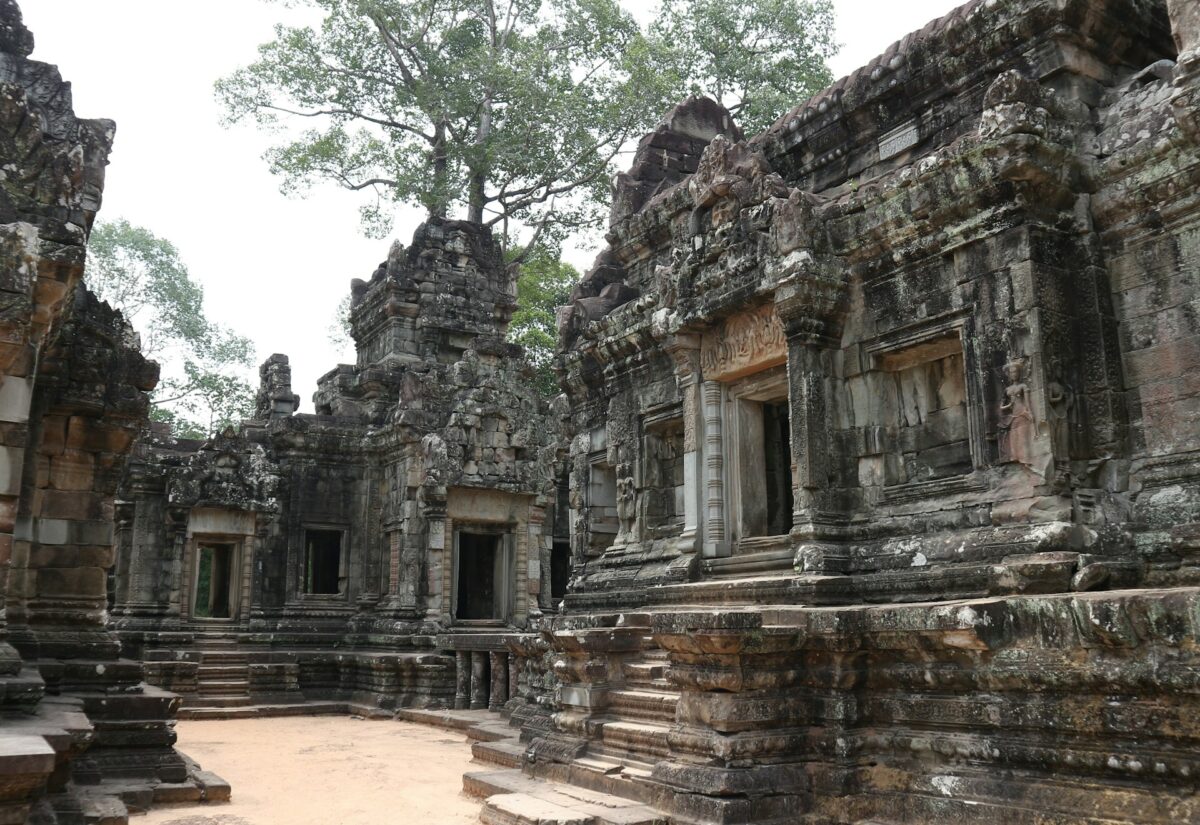 Unsplash/Getty
Unsplash/GettyThere’s something humbling about standing in the shadow of ancient ruins—knowing that centuries, or even millennia ago, people walked the same paths, built the same structures, and lived lives both alien and familiar to our own. Across the world, scattered among modern cities and remote landscapes, are crumbling temples, silent amphitheatres, and weathered stones that have outlasted empires. These aren’t just broken buildings or scenic backdrops for holiday snaps—they’re living reminders of everything we’ve inherited and everything we’ve lost. Here are 13 ancient ruins that will transport you back in time, even if some of them seem like obvious picks. They show up on lists like these for good reason.
1. Pompeii, Italy
Frozen in time by the catastrophic eruption of Mount Vesuvius in 79 AD, Pompeii offers an uncannily vivid glimpse into daily Roman life. Preserved under layers of volcanic ash, entire streets, villas, and even loaves of bread have survived nearly two millennia. The details are intimate—frescoes of mythological scenes, graffiti scrawled on walls, household tools left where they were dropped.
Walking through its bakeries, public baths, and brothels, you don’t just learn about Rome—you feel it. Pompeii isn’t some abstract lesson in history; it’s a story with real characters, frozen mid-sentence. It’s eerie and extraordinary, and despite how often it appears on travel lists, it’s still utterly unforgettable.
2. Petra, Jordan
Petra is one of those places that looks almost too perfect to be real. Carved directly into the rose-red cliffs by the Nabataeans more than 2,000 years ago, it was a thriving trade hub connecting Arabia, Egypt, and the Mediterranean. Its iconic Treasury is just the beginning—there’s a Roman-style theatre, ancient tombs, sacrificial altars, and a whole city hidden in the valleys and plateaus beyond.
Approaching it through the narrow Siq gorge builds an irresistible sense of drama. You emerge into the sunlight and there it is—massive, intricate, and timeless. Petra straddles the line between architecture and sculpture, myth and reality. You don’t just visit Petra. You enter it.
3. Machu Picchu, Peru
Perched dramatically on a mountain ridge high in the Andes, Machu Picchu is a marvel of Incan ingenuity. Built in the 15th century, abandoned just a century later, and largely unknown to the outside world until 1911, the citadel’s true purpose is still up for debate. Was it a royal retreat? A religious sanctuary? An astronomical observatory?
Whatever it was, it’s breathtaking—both literally and figuratively. The terraces cling to the mountainside with a precision that defies erosion, and the temples align with celestial events. The mist rolls in and out like a moving curtain, revealing stone walls that have stood against time and nature. It’s more than a postcard-perfect view. It’s a place that shifts your sense of scale and time.
4. Angkor Wat, Cambodia
Angkor Wat doesn’t just deserve its reputation—it exceeds it. Built in the early 12th century as a Hindu temple and later transformed into a Buddhist one, it’s the centrepiece of a massive archaeological park that includes hundreds of other ruins. The carvings stretch for miles. The scale is dizzying.
What makes Angkor truly compelling is the atmosphere. Jungle trees twist around stone columns. Roots cascade over ancient walls. It feels like the earth is in constant conversation with what humans left behind. At sunrise, with the towers reflected in the moat, it’s easy to forget the modern world exists at all.
5. Chichen Itza, Mexico
The Maya didn’t just build cities—they engineered them with the stars in mind. Chichen Itza, one of their most famous sites, is packed with astronomical, architectural, and ritual significance. The Temple of Kukulcán is perhaps its most famous feature. During the equinoxes, the sun creates a shadow that looks like a serpent slithering down the staircase.
Beyond the pyramid, there’s a giant ball court where ritual games once took place, a sacred cenote used for offerings, and an observatory designed to track Venus. It’s a place where science, religion, and politics collided—and it still commands reverence today.
6. The Colosseum, Rome, Italy
You’ve seen it in films, on T-shirts, and in the background of countless tourist photos. But the Colosseum’s fame hasn’t dulled its power. Completed in 80 AD, it was the epicentre of Roman entertainment—a place of bloodsport, drama, and spectacle.
Step inside and you can picture the roar of 50,000 spectators, the clash of swords, the pageantry of an empire on display. The hypogeum—the underground maze where animals and fighters waited—is still visible, a grim reminder of what those shows involved. The Colosseum isn’t just a monument to architecture. It’s a symbol of what humanity is capable of—good, bad, and awe-inspiring.
7. Mesa Verde, USA
Hidden within the cliffs of Colorado are the remains of a community that thrived over 700 years ago. Built by the Ancestral Puebloans, the dwellings at Mesa Verde range from small storage rooms to massive multi-storey villages carved into rock alcoves.
The engineering skill is extraordinary. These people adapted to arid, mountainous terrain with ingenuity—creating complex irrigation systems, ceremonial kivas, and defensive strongholds. What’s striking is how much of it feels personal. You’re not just looking at grand monuments—you’re walking through someone’s home, someone’s neighbourhood, someone’s community.
8. Stonehenge, England
Stonehenge is the ruin everyone thinks they already know. And yet, standing in its shadow, you realise why it never stops being talked about. Constructed between 3000 and 2000 BC, its exact purpose is still unclear. Was it a calendar? A burial ground? A religious site? Possibly all three—or none of the above.
What is clear is the scale of the effort it took to build, and the mystery that still clings to every stone. Even after thousands of years, Stonehenge hasn’t given up all its secrets. That’s part of its power. You don’t just look at Stonehenge. You puzzle over it. You wonder, like everyone else has, what it all meant.
9. The Great Wall of China
It’s one of the most iconic man-made structures on Earth—but what many don’t realise is just how diverse it is. The Great Wall isn’t one unbroken line. It’s a series of walls, towers, and fortifications built by different dynasties across different terrains, stretching over 13,000 miles in total.
Walking a wild section of the wall—overgrown, uneven, untouched by mass tourism—you can sense the weight of history in each stone. It was built not just to repel invaders, but to define and protect a civilisation. It’s a symbol of endurance, complexity, and human will.
10. Palmyra, Syria
In its prime, Palmyra was a glittering trade hub that bridged the Roman and Persian worlds. Its architecture reflected that cultural blend—classical columns alongside local flourishes, grand temples beside desert courtyards. It was a cosmopolitan place where East met West.
More recently, it became a symbol of what can be lost. Parts of the city were destroyed during modern conflict, a devastating blow to world heritage. But what survives—arches, tombs, temples—reminds us of what this city once was, and why preserving history matters so deeply.
11. Tikal, Guatemala
Tikal isn’t easy to reach, but that’s part of the magic. Set deep within the Guatemalan jungle, this ancient Maya city rises from the treetops like a mirage. Its steep pyramids poke through the canopy, and howler monkeys provide the soundtrack.
This was once a city of tens of thousands, with a complex political system, astronomical observatories, and a network of causeways. Today, it feels half-lost to the forest—but in the best possible way. Tikal doesn’t just show you the past. It immerses you in it.
12. Delphi, Greece
Delphi was the centre of the ancient Greek world—literally. A stone marker in the temple marked it as the omphalos, the navel of the Earth. Here, people came to consult the Oracle of Apollo, hoping for guidance wrapped in riddles.
Set on the slopes of Mount Parnassus, with sweeping views and layered terraces, Delphi still feels sacred. The amphitheatre, the temples, the treasuries—they speak of devotion, ambition, and the desire to understand life’s mysteries. There’s a serenity to Delphi that lingers long after you’ve left.
13. Hampi, India
Once the capital of one of the richest empires in the world, Hampi is now a surreal sprawl of boulders and temples in southern India. It’s a place of strange contrasts—giant stones that look haphazard until you realise they’re the backdrop to entire cities.
Hampi was the heart of the Vijayanagara Empire, a thriving centre of trade, religion, and art in the 14th to 16th centuries. Walk its streets today and you’ll find temples with intricate carvings, royal elephant stables, and market avenues that still feel lived-in. It’s not polished. It’s raw and majestic and very much alive.
These ancient ruins aren’t just relics. They’re reminders—of ingenuity, belief, empire, and collapse. They show us that for all our modern advances, we’re still asking some of the same questions, still drawn to the same beauty, still building on foundations laid by people long gone. They’re not just worth visiting. They’re worth listening to.



